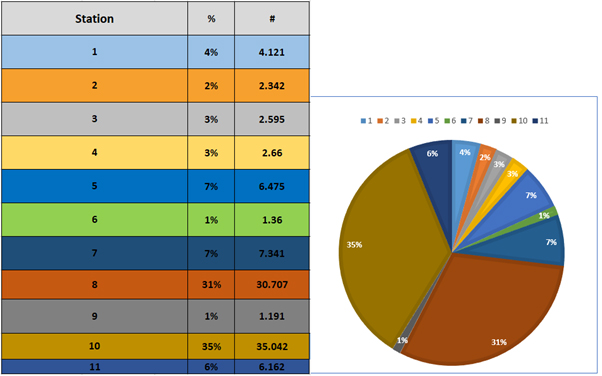Determining the sources and distribution of polycyclic aromatic hydrocarbons in the soil of different oil fields at Basrah governorate, Iraq
DOI:
https://doi.org/10.15587/2706-5448.2023.293837Keywords:
polycyclic aromatic hydrocarbons, PAHs, soil pollution, oil fields, Basrah governorateAbstract
The object of the research is polycyclic aromatic hydrocarbons (PAHs). For the purpose of determining the source and distribution of PAHs, soil samples from the 11 oil fields in the Basrah governorate (Seba, Safwan, Majnoon, Ratawi, Bergezia, Qurna1, Qurna2, Shuaaba, South and North Rumaila, and al Zubair) were taken at a depth of 0 to 20 cm. According to their molecular weight, they were separated into two main groupings. The first group of compounds consisted of six compounds: naphthalene, acenaphthylene, acenaphthene, fluorene, phenanthrene, and anthracene. These light (low molecular weight) compounds have two to three fused aromatic rings. The first group includes nine chemicals: floranthene, pyrene, benzo(a)anthracene, chrysene, benzo(b), benzo(k), benzo(a), benzo(a), indeno(1,2,3,c,d), and benzo(g,h,i)perylene. These heavy (high molecular weight) compounds included four or more fused aromatic rings. The PAHs compounds ranged in value from the lowest (0.16 ng/g dry weight of benzo(a)anthracene at station West Quarna1) to the highest (680 ng/g dry weight of benzo(g,h,i)perylene that emerged at station North Rumail). The total concentration of PAHs ranged from 77.67 ng/g in South Rumaila Field while highest concentration is 2284.27 ng/g in North Rumail. The PAHs compound has low and high molecular weight, their ratio of LMW/HMW (low molecular weight/high molecular weight) and phenanthrene/anthracene, fluoranthene/pyrene indicated that the source of PAHs was pyrogenic only. The PAH diagnostic ratios and principal component analysis (PCA) indicated that PAHs in soils essentially originated from emissions and combustion. This study gave a baseline on the source and distribution of these compounds in oil fields at Basrah governorate and can be used as a baseline for coming study in the future.
References
- Patel, K. S., Ramteke, S., Naik, Y., Sahu, B. L., Sharma, S., Lintelmann, J., Georg, M. (2015). Contamination of Environment with Polycyclic Aromatic Hydrocarbons in India. Journal of Environmental Protection, 6 (11), 1268–1278. doi: https://doi.org/10.4236/jep.2015.611111
- Saleem, F. M. (2022). Distribution, Sources and Human Risk Assessment of n- alkane and PAHs Compounds in Soil at Basrah City. University of Basrah.
- Obayori, O. S., Salam, L. B. (2010). Degradation of polycyclic aromatic hydrocarbons: Role of plasmids. Scientific Research and Essays, 5 (25), 4093–4106.
- An exposure and risk assessment for benzo(a)pyrene and other polycyclic aromatic hydrocarbons: Volume II. Naphthalene (1982). USEPA, Office of Water Regulations and Standards. Washington.
- Al-Saad, H., Farid, W., Abdul-Ameer, W. (2019). Distribution and sources of polycyclic aromatic hydrocarbons in soils along the Shatt Al-Arab River Delta in southern Iraq. Soil and Water Research, 14 (2), 84–93. doi: https://doi.org/10.17221/38/2018-swr
- Farid, W. A., Al-Salman, A. N., Ali, W. A., Al-Saad, H. T., Mahdi, S., Al-Hello, A. A. (2016). Polycyclic Aromatic Hydrocarbons (PAHs) in the Surface Sediments of Shatt Al-Arab River, Basrah City, Southern Iraq. Journal of Natural Sciences Research, 6 (8), 46–55.
- Karem, D. S. A. (2016). Environmental Impact Assessment of Air, Noise and Petroleum Hydrocarbons Pollution in Soil of West Qurna-2 Oil Field at Basrah city, Southern Iraq. University of Basrah, 166.
- Khwedim, K. (2016). Crude Oil Spillage and the Impact of Drilling Processes on the Soil at Rumaila Oil Field- Southern Iraq. Iraqi Journal of Science, 57 (2A), 918–929.
- Kadhim, H. A. (2019). Assessment of Environmental Pollution in West Qurna1 Oil Field at Basrah Governate, Iraq. University of Basrah, 190.
- Jalal, G. K. (2020). Urban Environmental Geochemistry of Basrah City, Southern Iraq. University of Basrah, 181.
- Abed, M. F., Ali, S. M., Altawash, B. S. (2015). Health Risk Assessment of Polycyclic Aromatic Hydrocarbons in Surface Soils at North Baiji City, Iraq. Iraqi Journal of Science, 56 (4A), 2927–2938.
- Alawi, M. A., Azeez, A. L. (2016). Study of polycyclic aromatic hydrocarbons (PAHs) in soil samples from Al-Ahdab oil field in Waset Region, Iraq. Toxin Reviews, 35 (3-4), 69–76. doi: https://doi.org/10.1080/15569543.2016.1198379
- Ali, L. A. (2013). Environmental Impact Assessment Of Kirkuk Oil Refinery. Baghdad University, 217.
- Essa, H. N., Mohsin, E. A. (2016). Study of Crude oil spills and gas burning of accompanied natural gas on the environment of Nasiriyah oil field southern Iraq. Diqar science Journal, 6 (1), 52–59.
- Jasim, A. J. (2017). Evaluation and monitoring the impact environmental pollution in water and soil south of Baghdad. Research Journal of Pharmaceutical, Biological and Chemical Sciences, 8 (4), 659–663.
- Kadhim, A. J., Salman, J. M. (2018). Evaluation PAHs in Agriculture soil samples-AL-Khacheya site south of Baghdad. Iraq. Plant Archives, 18 (1), 1005–1008.
- Al-Rudaini, T. K. M., Almousawi, I. M. H. (2018). Determination of Polycyclic Aromatic Hydrocarbon in soil at AL-Nahrawan bricks factory. Pakistan Journal of Biotechnology, 15 (2), 445–450.
- Al-Rudaini, T. K. M., Almousawi, I. M. H., Al-Sammarraie, A. M. A. (2019). Environmental Assessment of Polycyclic Aromatic Hydrocarbon Concentrations in soil at AL-Zubaidiya Thermal Power Plant. Journal of Physics: Conference Series, 1294 (5), 052010. doi: https://doi.org/10.1088/1742-6596/1294/5/052010
- Aoeed, Y. H., Mohammed, A. B., Hameed, A. M. (2021). Concentration of some Polycyclic Aromatic Hydrocarbons in soil samples of Kirkuk province, Iraq. IOP Conference Series: Earth and Environmental Science, 877 (1), 012023. doi: https://doi.org/10.1088/1755-1315/877/1/012023

Downloads
Published
How to Cite
Issue
Section
License
Copyright (c) 2023 Hamid T. Al-Saad, Hamza K. Abdulhassan, Majdalena A. Resen

This work is licensed under a Creative Commons Attribution 4.0 International License.
The consolidation and conditions for the transfer of copyright (identification of authorship) is carried out in the License Agreement. In particular, the authors reserve the right to the authorship of their manuscript and transfer the first publication of this work to the journal under the terms of the Creative Commons CC BY license. At the same time, they have the right to conclude on their own additional agreements concerning the non-exclusive distribution of the work in the form in which it was published by this journal, but provided that the link to the first publication of the article in this journal is preserved.







